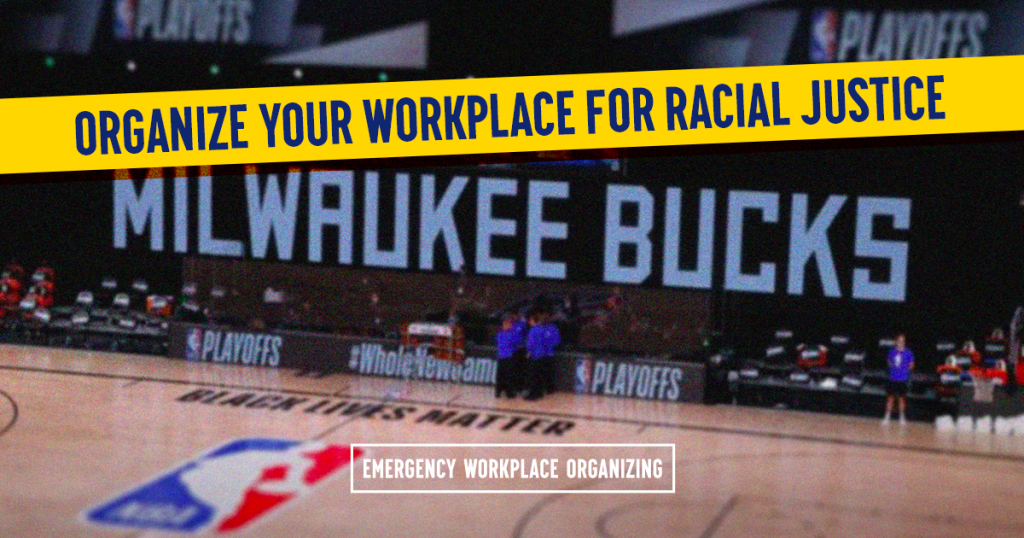In their righteous wildcat strike, professional athletes showed us both how collective action can directly challenge power, but also how a workplace campaign can get cut short if we’re not prepared.

It’s an all-too-common experience in workplace organizing: You and your coworkers have been grumbling about injustices at work for a while but haven’t taken any action. Suddenly a crisis hits and there is a wave of enthusiasm for organizing. “We’ve gotta DO SOMETHING,” people say as they start rallying together. Even typically cautious workers are talking about something big, maybe a walkout. You channel that energy into a confrontation with the boss, but then…it fizzles out. People aren’t so sure about taking risks anymore. The momentum is lost. Maybe you got a minor concession, but conditions remain pretty much the same.
We all witnessed this scenario unfold before us as NBA, WNBA, and MLB players bravely struck for racial justice after police shot and paralyzed Jacob Blake in Kenosha, WI. Players risked their careers and reputations by violating their contracts and refusing to play. In doing so, they used their platform to criticize capitalism and support Black liberation, and they leveraged their irreplaceable labor to seriously threaten the team owners’ and media corporations’ bottom lines. But just days later, players returned to the courts and the fields with no clear victory. While we can’t know exactly what happened behind the scenes – and while any battle with employers is a major undertaking, particularly in the high-pressure spotlight of professional sports – we can see they encountered the same obstacles that any labor organizer could face, be they a bus driver, a bartender, or a basketball player.
Every workplace action benefits from:
- Clear and specific demands. The Milwaukee Bucks, who kicked off the strike wave by refusing to play, urged the Wisconsin state legislature to “take up meaningful measures to address issues of police accountability, brutality and criminal justice reform.” They smartly identified their target – state legislators – but naming which meaningful measures could have set a concrete benchmark for determining whether their demands had been met or further escalation was needed. Specific policy changes described in #8toAbolition, for example, could serve as a model for concrete changes that the legislature is empowered to make, such as removing police from schools and hospitals, withdrawing from police militarization contracts, and funding public housing.
- A plan of escalation. LeBron James of the Los Angeles Lakers, one of the lead organizers of the strike, “viewed the Bucks’ initial move – while well-intentioned – as lacking a plan.” Sometimes workplace actions happen spontaneously, and when they do it’s on us to deepen that conflict and take advantage of that energy. Organizers should immediately ask: What is the deadline for our demands? If the target doesn’t comply, how can we up the ante? What will we leverage to put more pressure on the decision makers? How can we get more workers to participate? How should we ask the community to support us?
- Inoculation to prevent defections. Barack Obama and Michael Jordan encouraged players to return to the game and instead establish a “social justice committee,” which likely cut into the momentum of the strike. It’s rarely the case that workers win their demands immediately, and it can be tough to maintain a fighting spirit until you do. That’s why it’s critical to prepare each other for possible obstacles. How will the boss try to convince us to back down? What if they retaliate? When people know what to expect and trust that their coworkers have their back, they are much more likely to hold their ground.
The impact of the athletes’ strike shouldn’t be minimized: They touched millions of people with their commitment to freedom from police violence, likely inspiring many workers to take up issues of racial justice as a demand. It is only through multiracial solidarity and collective action such as theirs that we can win. Labor organizers benefit from watching a campaign in action and learning from both their successes and struggles. We can see that for a strike to succeed, workers need more than righteous anger – we need to be organized.
Want to fight for a better world with your coworkers? Get in contact with an organizer who can help!



